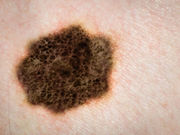Case report describes acneiform eruptions after tx of metastatic melanoma lesions with vemurafenib
MONDAY, Aug. 29, 2016 (HealthDay News) — Acneiform eruptions due to the BRAF kinase inhibitor (BRAFi) vemurafenib in a patient with multiple metastatic melanoma lesions are described in a case report published online Aug. 11 in the Journal of Dermatology.
Osamu Ansai, from the Niigata University Graduate School of Medicine in Japan, and colleagues describe the case of a 54-year-old man with a history of malignant melanoma who underwent wide local excision and one year of β-interferon therapy. Multiple metastatic lesions were found on computed tomography three years later. As his tumor cells were BRAF V600E mutation positive, he started therapy with vemurafenib twice daily.
The authors note that the patient presented with painful and itchy erythemas and nodules with numerous comedones on his lower jaw within one week of starting therapy. Numerous well-circumscribed red papules and nodules increased and expanded to perioral, perinasal, and eyebrow, despite treatment with oral minocycline and topical hydrocortisone. Open and closed comedones surrounding acanthotic and intricate epidermal wall were seen on biopsy. Around the comedones, numerous lymphocytes and neutrophils infiltrated. No pathogenic bacteria and fungi were identified on culture of pustules on the face.
“Our report provides a crucial information to better understand cutaneous adverse events caused by BRAFi, and also suggests that retinoids can be effective in BRAFi-induced acneiform eruptions,” the authors write.
Full Text (subscription or payment may be required)
Copyright © 2016 HealthDay. All rights reserved.








